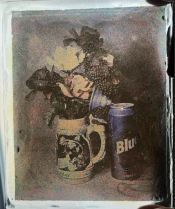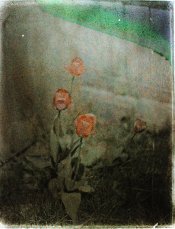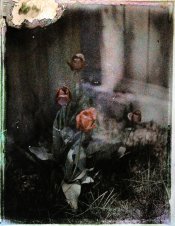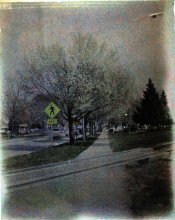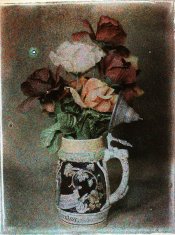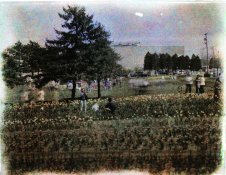Alright, I have to admit I'm officially driving myself crazy now. I've shot well over 100 plates over and over again of the same scene, and quite a few different ones outside just to make sure there's not something wrong with my light.
The problem: I can reliably achieve color, but I just can't get anywhere near the dynamic range that original autochrome plates had. Bright colors always involve blown out highlights, and oftentimes weak shadows.
Good colors with longer development often leads to horribly contrasty scenes. Reducing development and increasing exposure time brings down the contrast and sometimes can muddy the colors, but still my midtones are very weak and shadows/highlights tend to overpower the image. Normal exposure times and longer development result in a nice image contrast, but the color is hopelessly washed, if not non-existent.
So far I've tried exposures ranging from 1 - 60 minutes. Developers I've tried:
Rodinal (concentrations ranging from 1+10 to 1+100, dev times ranging from 2 - 25 minutes)
D-23 in varying concentrations and times. Tried it with KSCN from 1-5g/L
D-76 in varying concentrations and KSCN/Hypo content
D-19 in varying concentrations and KSCN content
Dufaycolor FD in varying concentrations and various KSCN content.
Various ammonia based MQ developers from old photographic journals, with varying concentration and development times.
I guess the only developer I haven't really hit these with yet is the good ol' ammonia-pyro formula that was originally recommended for autochromes.
Also in combination, I have been trying various emulsion AgX contents. Generally, I just create my main batch of emulsion, and dilute it down with a 2.8% gelatin solution, and apply 12mL (full draw of a 10mL syringe) to each 4x5 plate. I've tried anywhere between no dilution to 1:16. 1:4 and 1:8 seem the most correct regarding processing times from old autochrome articles, and most of my experimentation has been near those two concentrations.
I don't know, I'm honestly pulling my hair out at this point. I'm guessing I need to start tweaking my emulsion recipe. I'm still using the same one I referenced earlier, and still including the sulfur sensitization. I don't think it's a particularly high contrast emulsion though, but I could nix the sulfur sensitization, and maybe start to think about pulling back on the amount of KI I add too.
I've been hitting The History of Color Photography pretty hard, specifically the chapter on processing screen plates, and even more specifically the section on reversal processing. So at the very least, I'm learning a lot, even if I don't have much to show for it. A lot of scenarios in my experimentation, I've noticed, result in the developer not penetrating all the way to the bottom of the gelatin layer (where it receives the most exposure). In one particularly thick plate, there was additional AgX even after both first and second development, that really didn't reveal itself until I hit it with a reducer.
This explains a phenomenon I've been seeing, where the plate, when immersed in the second developer, appears as a positive akin to a tintype for a minute or so before fading black. The upper part of the layer, where the bleached image is, develops first, and the milky, untouched AgX on at the bottom shows through the bleached areas, so that they appear white.
These upper layers are where the light is scattered most. Typically a silver solvent (like ammonia, KSCN or hypo) eats away at these, while allowing the developer to penetrate into the emulsion and do its job.
I had one scenario where I got a really nice looking plate. I had hit a thicker plate with a 30 minute exposure and a long development in a very diluted ammonia based developer. After second development it was hopelessly dark, with the positive image barely visible even when held against a light bulb. I hit it with a superproportional reducer based on ammonium persulfate and sulfuric acid. To my surprise, though it lost a good amount of highlight detail, it retained very nice colors and dynamic range. This was a one-off experience that I haven't yet been able to reproduce. I'm assuming the long development time allowed the developer to penetrate deep into the emulsion and develop the bottom of the emulsion, and then the reducer ate away at the big blanket of silver at the top of the emulsion that was left there after second dev.
The good news is that I was able to make some progress on sorting the starch grains, which is a small baby step forward at least.
P.S. I just had a crazy thought - shorter exposures (1 minute or so) with development times on the longer side tend to look washed, but generally take on a blue tint. I'm wondering, is it possible that with a screen plate process, are the AgX behind blue grains being exposed first, yet still hang around blocking blue rays while the AgX behind the red/green grains "catch up"? Maybe this is why the longer the exposure is, the more balanced in color it seems. And with shorter exposures, there would be a larger concentration of exposed AgX behind blue grains. Maybe my emulsion isn't very well balanced for color after all?



